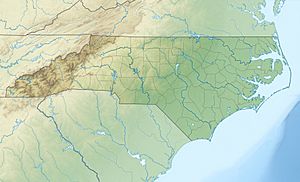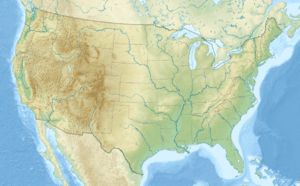Wolfpit Branch (Swannanoa River tributary) facts for kids
Quick facts for kids Wolfpit Branch |
|
|---|---|
|
Location of Wolfpit Branch mouth
|
|
| Other name(s) | Tributary to Swannanoa River |
| Country | United States |
| State | North Carolina |
| County | Buncombe |
| City | Black Mountain |
| Physical characteristics | |
| Main source | divide between Wolfpit Branch and Broad River about 3 miles south of Black Mountain, North Carolina 3,640 ft (1,110 m) 35°34′19″N 082°20′30″W / 35.57194°N 82.34167°W |
| River mouth | Swannanoa River Black Mountain, North Carolina 2,270 ft (690 m) 35°36′28″N 082°20′26″W / 35.60778°N 82.34056°W |
| Length | 2.55 mi (4.10 km) |
| Basin features | |
| Progression | north |
| River system | French Broad River |
| Basin size | 1.78 square miles (4.6 km2) |
| Tributaries |
|
| Bridges | Amphitheater Lane, Lee Hall Circle, Blue Ridge Circle, Maney Lane, I-40 |
Wolfpit Branch is a small stream, about 2.55 mi (4.10 km) long, located in Buncombe County, North Carolina. It is a "tributary," which means it's a smaller stream that flows into a larger river. Wolfpit Branch flows into the Swannanoa River.
Where Does Wolfpit Branch Flow?
Wolfpit Branch begins its journey about 3 miles (4.8 km) south of a town called Black Mountain, North Carolina. It starts in Buncombe County.
The stream's starting point is near a "divide." A divide is a high area of land that separates different river systems. Here, it separates the waters that flow into Wolfpit Branch from those that flow into the Broad River.
From its source, Wolfpit Branch flows generally north. It continues until it reaches and joins the Swannanoa River, right in the town of Black Mountain, North Carolina.
The Area Around the Stream
The land area that Wolfpit Branch collects water from is called its "watershed." This watershed covers about 1.78 square miles (4.6 km2) (4.6 square kilometers).
This area gets a good amount of rain and snow each year, about 50 inches (127 cm) of "precipitation." This water helps feed the stream.
A large part of the Wolfpit Branch watershed, about 91%, is covered by forests. These forests are important for keeping the water clean and healthy for any plants and animals living there.



